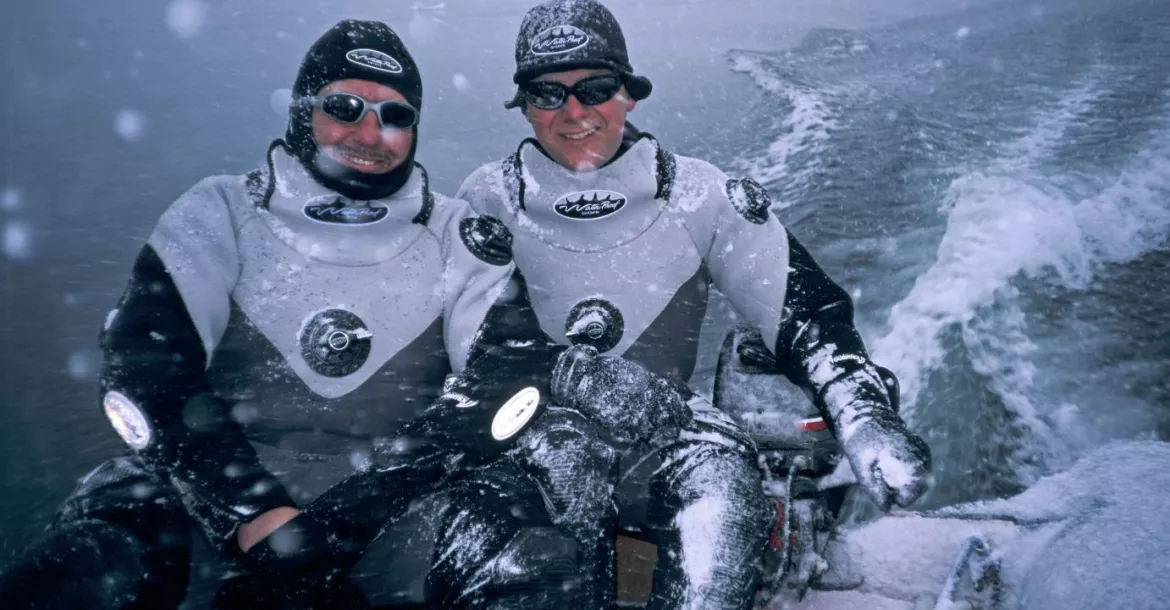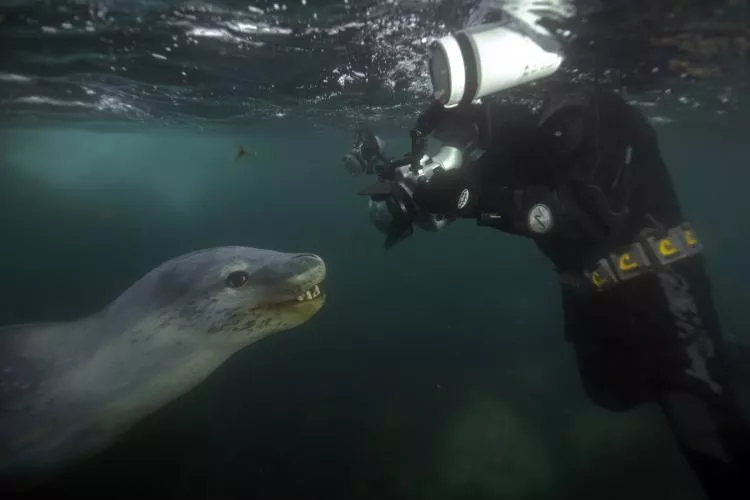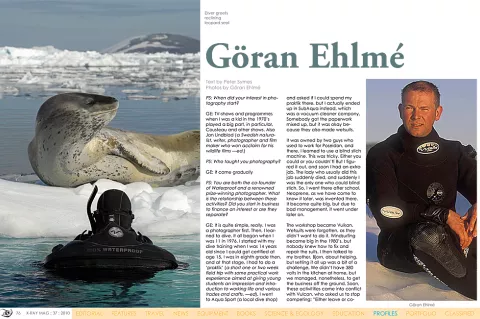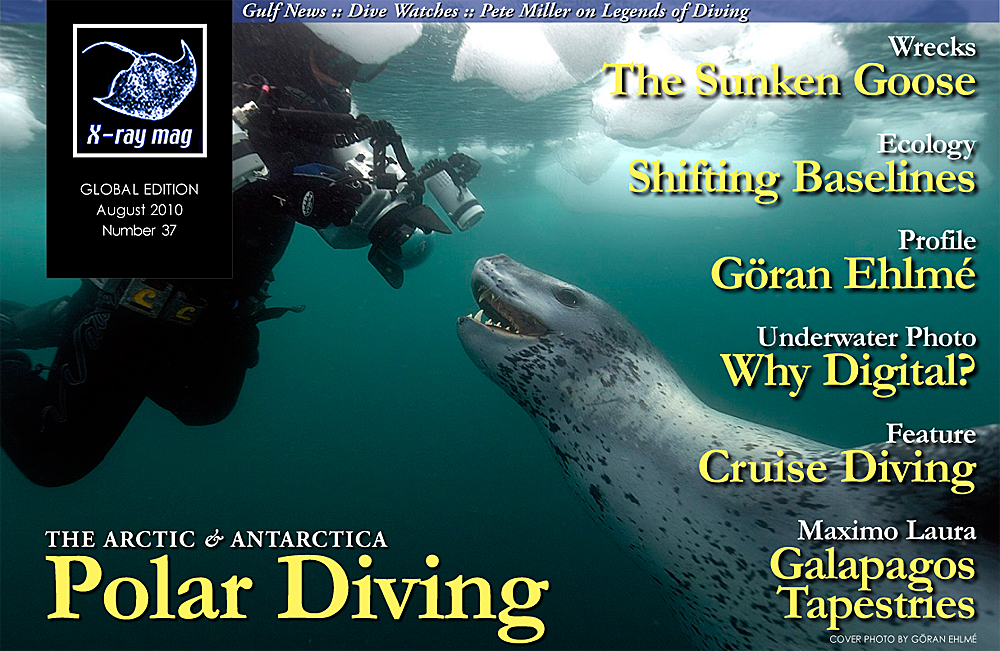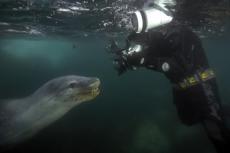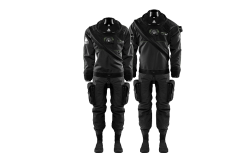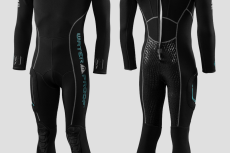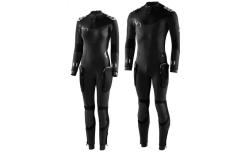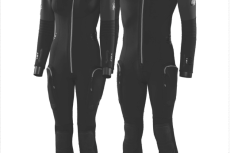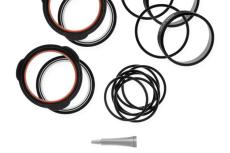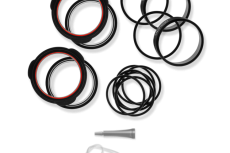Göran Ehlmé of Sweden has planned and led many field trips to the polar areas and was the first to lead diving expeditions to the Arctic and Antarctica.
As an underwater cameraman, Ehlmé has been on assignment filming many documentaries for Animal Planet, BBC, Canal Plus and National Geographic
Contributed by
PS: When did your interest in photography start?
GE: TV-shows and programmes when I was a kid in the 1970’s played a big part, in particular, Cousteau and other shows. Also Jan Lindblad (a Swedish naturalist, writer, photographer and film maker who won acclaim for his wildlife films —ed.)
PS: Who taught you photography?
GE: It came gradually
PS: You are both the co-founder of Waterproof and a renowned prize-winning photographer. What is the relationship between these activities? Did you start in business to finance an interest or are they separate?
GE: It is quite simple, really. I was a photographer first. Then, I learned to dive. It all began when I was 11 in 1976. I started with my dive training when I was 14 years old since I could get certified at age 15. I was in eighth grade then, and at that stage, I had to do a ’praktik’ (a short one or two week field trip with some practical work experience aimed at giving young students an impression and introduction to working life and various trades and crafts. —ed). I went to Aqua Sport (a local dive shop) and asked if I could spend my praktik there, but I actually ended up in SubAqua instead, which was a vacuum cleaner company. Somebody got the paperwork mixed up, but it was okay be-
cause they also made wetsuits.
It was owned by two guys who used to work for Poseidon, and there, I learned to use a blind stich machine. This was tricky. Either you could or you couldn’t! But I figured it out, and soon I had an extra job. The lady who usually did this job suddenly died, and suddenly I was the only one who could blind stich. So, I went there after school. Neoprene, as we have come to know it later, was invented there. It became quite big, but due to bad management, it went under later on.
The workshop became Vulkan. Wetsuits were forgotten, as they didn’t want to do it. Windsurfing became big in the 1980’s, but nobody knew how to fix and repair the suits. I then talked to my brother, Bjorn, about helping, but setting it all up was a bit of a challenge. We didn’t have 380 volts in the kitchen at home, but we managed, nonetheless, to get the business off the ground. Soon, these activitities came into conflict with Vulcan, who asked us to stop competing: ”Either leave or co-operate”. So, we started Waterproof in 1984 while I was working as a carpenter at the same time.
But constructing wetsuits felt right as the ocean was dear to me. As [land] photography was dear to me, too, taking the photography down under the surface was only the next logical step
I bought an underwater camera (from AquaSport, incidentially). It was a Nikonos IVa. The first images—30 rolls shot in the Red Sea—were a complete disaster. They were all over-exposed, so I put underwater photography on the shelf for a while.
But in 1987-88, I was going up to Lofoten and I got off to a new start.
Waterproof and I are the same thing. I can always justify diving and taking pictures doing it because it brings pictures to our catalogues. The force that pushes me forward is having a good time, and in the beginning, it was purely for fun. It was only later it became professional. There was never money in stills even in the 1980’s. That is why I went into video.
Now, we have more owners. That is because I do not want to be in conflict with what I do.
We can sit in the office and design beautiful items, but you can really only work on the visual appearance. You have to be in the field. Most of the time outside, you wait for wildlife. Ninety percent of the time, you wait. Sometimes you wait for eight hours in your drysuit, so you will notice if something is not working. You don’t necessarily do that after one hour.
PS: Waterproof was one of the first, if not the first, to use cold water destinations in the marketing. I am referring to some of your early work and Waterproof promotions that was shot on Iceland in the 1980’s. Where did that idea come from?
GE: I like the tropical seas, but it is not my world. It doesn’t touch my heart, as I do not get to see stuff that I understand. In cold waters, I find animals I know from home. I grew up in Scandinavia. I like to see animals that I can somehow relate to, that touches me. But destinations like, for example, New Zealand also work for me.
I dislike that the world is turning into a Disney World where you are told what to do. Everything is prefabricated down to the tracks of the rainforest. I hate it when there is no adventure.
When I went to Iceland, it was actually prohibited to dive in Thingvellir, though some years earlier, some black and white images were taken for Poseidon up there.
PS: You seem to have a preference for the colder regions of the planet? Where did that interest come from? What do the polar regions have to offer divers that tropical destinations don’t?
GE: Diving in cold water means that you can explore locations where nobody else has been, just like Ernst Shackleton or Roald Amundsen, and there are no people around. You are back to being an explorer, that is what I love. In the tropics, you can’t explore anymore.
To me cold water also means tranquility and an untouchable frontier.
PS : What is the most important lessons you have learned about wildlife by having interacted with them?
GE: : In regards to marine mammals, it is important to realise how very similar we are to them. It is really surprising, actually. A lot of animals like to interact with humans. They care for their young, and they are gentle towards humans—they mean no harm.
You don’t expect animals to kick you just for the fun of it. You don’t let your fear interfere with your interaction with the animals. In the old days, you would not make the distinction between curiosity and an attack, and scare stories sold more newspapers.
The more time you spend with the animals, the more logical it all seems, and it begins to make sense. We are not all that dissimilar.
PS: : Are there any other creatures you would like to document in the future?
GE: I would still work with the polar regions. So far, I have only done ”the easy parts”. I would definitively like to do the emperor penguins. They are always out to open sea and quite tricky to follow. Also, the Giant octopus and
feeding Sperm whales are high on my list of priorities.
PS: What do you look for in an image? What makes a picture great in your opinion?
GE: Tricky question. It can be so many things.
PS: Video or still photography? When is one media better than the other?
GE: In the recent years, I have been working mostly with stills because it is easier and the equipment is lighter and less complicated, which makes it more fun. I have gone back to video lately though, but it requires more people. For me, it is 50-50 which one I prefer.
PS: Where do you see the biggest (technological) advances taking place?
GE: What I learned when I dealt in white shirts was that they were all made in Bangladesh, so it was meaningless to discuss quality. It is a matter of design. The same principle applies to photography; you can pretty much decide on the quality you want.
The big question at the moment is will Nikon and Canon take over the video market, or will Sony and Panasonic take over the still photography market? Evidently, the technologies are about to fuse. Still photography as we know it today will go extinct, wiped out by what BBC and National Geographic are capable of. They can just take frames out of their High Definition videos. Nobody can compete with that.
PS: Which features would you like to see invented?
GE: Sidescan sonar video. The side scan sonar images are nice, so just imagine if you could do the same with video. You could use sound to see really deep and record what i.e. the Sperm whales are doing. Imagine what you could see.
PS: Who inpires you? Do you have any role models?
GE: I have no clue really. Do what you like, be happy and have a good time.
PS: What other dreams would you like to live out before you retire?
GE: Hmmm..... just to see some other places. I already travel a lot. Perhaps seeing British Columbia. But I am already living my dream. I never had to work for the sake of making money. I always enjoyed what I do and have been lucky making money doing so. ■
Background
Göran Ehlmé of Sweden has planned and led many field trips to the polar areas and was the first to lead diving expeditions to the Arctic and Antarctica.
He has more than 24 years diving experience, is a certified PADI Instructor and has been diving the polar areas since 1993. He dives both open water and under the ice during summer and is particularly experienced with walrus, emperor penguins and leopard Seals.
With Waterproof Expeditions, he likes to share his experiences of the polar regions with divers around the world. As an underwater cameraman, Ehlmé has been on assignment filming many documentaries for Animal Planet, BBC, Canal Plus and National Geographic. He recently won the BBC’s Shell Wildlife Photographer of the Year 2006 award with his winning image of a feeding walrus underwater in North East Greenland. (see next page)
Ehlmé has filmed beluga, narwhal, seals, walrus and other mammals in the Canadian Arctic, Greenland and Svalbard. In Antarctica, he filmed humpback and minke whales and all the members of the seal family including the leopard seal. He has also captured most penguin species, including emperor penguins, as well as many invertebrates on film. In the Azores (Faial and San Miguel) he spent four seasons diving with sperm whales, and since 1985, he has been diving with orcas in Norway and became familiar with the whales themselves and the logistics and techniques involved in getting close to them.
Ehlmé’s footage has been used in numerous series and films over the past ten years.
- Archives of Emperor Penguins under water in the Hollywood Production, March of the penguins, 2006
- Lord of the ice: Leopard seals (Discovery/Saint Thomas Productions, 2003)
- What do the walruses know? (SVT,DR, 2003)
- Wildlife special: Killer whales (BBC/Discovery, 2003)
- Hunt for the red whale: Killer whales (Survival, 2003)
- Blue planet: Frozen seas (BBC/Discovery, 2002, narwhal, walrus and emperor penguins)
- Toothed titans (National Geographic, 1999, feeding walrus sequence)
- White whales and narwhals chattering of ghosts (Canal+, 1999)
- Lea the Leopard Seal (Saint Thomas/Canal+, 1998)
- Avaq: The Arctic toothwalker; walrus (Scandinature)
- Svalbard: Where the polar bears reign; walrus (Scandinature)
For his company, Waterproof International in Sweden, Ehlmé is the head designer of neoprene drysuits, wetsuits and accessories. He has been testing the suits during is camera work in the polar regions and has designed them with his experiences in mind. The quality and design of the suits have won many awards for the best suits all over the world. ■

